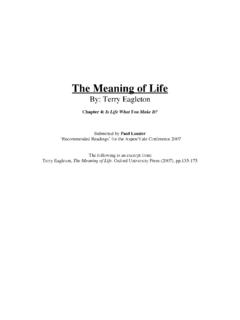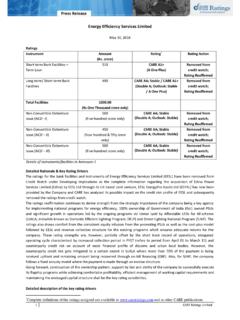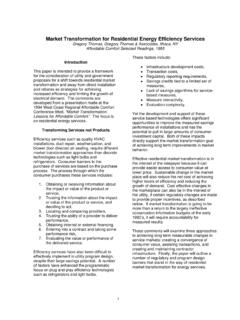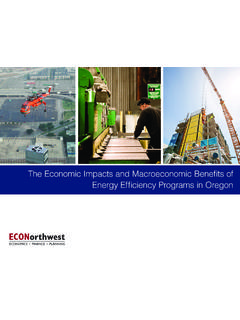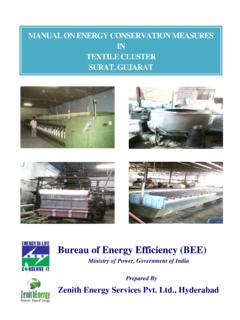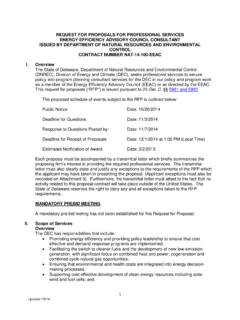Transcription of The Rebound Effect and Energy Efficiency Policy
1 1 The Rebound Effect and Energy Efficiency Policy Kenneth Gillingham*, David Rapson , and Gernot Wagner September 25, 2015 Forthcoming, Review of Environmental Economics and Policy Abstract What do we know about the size of the Rebound Effect , the well-known phenomenon that improving Energy Efficiency may save less Energy than expected due to a Rebound of Energy use? Is there any validity to the claims that Energy Efficiency improvements can actually lead to an increase in Energy use (known as backfire )? This article clarifies what the Rebound Effect is, and provides a guide for economists and policymakers interested in its existence and magnitude.
2 We discuss how some studies in the literature consider a Rebound Effect that results from a costless exogenous increase in Energy Efficiency , while others examine the effects of a specific Energy Efficiency Policy a distinction that leads to very different welfare and Policy implications. We present the most reliable evidence available about the size of the Energy Efficiency Rebound Effect , and discuss situations where such estimation is extraordinarily difficult. With this in mind, we present a new way of thinking about the macroeconomic Rebound Effect . We conclude that overall, the existing research provides little support for the so-called backfire hypothesis.
3 However, our understanding of the macroeconomic Rebound Effect remains limited , particularly as it relates to induced innovation and productivity growth. JEL classification numbers: H23, Q38, Q41. Keywords: Energy Efficiency , Rebound Effect , take-back Effect , backfire, Jevons Paradox. * Yale University and the National Bureau of Economic Research; e-mail: University of California, Davis; e-mail: Environmental Defense Fund, and School of International and Public Affairs, Columbia University; e-mail: 2 INTRODUCTION Buy a more fuel-efficient car, drive more.
4 This is perhaps the simplest illustration of what has come to be known as the Rebound Effect the phenomenon that an increase in Energy Efficiency may lead to less Energy savings than would be expected by simply multiplying the change in Energy Efficiency by the Energy use prior to the change. The existence of the Rebound Effect has been clear for a long time. In fact, Jevons (1865) hypothesized that greater Energy Efficiency may even lead to a backfire, whereby industrial Energy use increases. However, the size of the Rebound Effect is much less clear. There is great variation in estimates, which stems from differences in definitions of the Rebound Effect , as well as in the quality of the data and the empirical methodologies used to estimate it.
5 This has clear Policy implications because both researchers and Policy makers need reliable information about the magnitude of the Rebound Effect to evaluate the Energy savings and economic welfare implications of Energy Efficiency policies. While the Rebound Effect is just one component of this more important analysis, it has received significant attention, including in the popular media, which is often in search of counter-intuitive results. The goal of this article is to more clearly define the Rebound Effect in the context of Energy Efficiency improvements, including clarifying its various channels, and to critically assess the literature that estimates its magnitude.
6 In particular, we distinguish between the Rebound Effect from a costless exogenous Energy Efficiency improvement what we will refer to here as a zero-cost breakthrough and the Rebound Effect from an actual (typically costly) Energy Efficiency Policy what we will refer to here as a Policy -induced improvement. Recognition of 3 this distinction can be helpful for interpreting estimates in the literature, which often conflate the two, leading to inappropriate conclusions and an exaggerated Rebound Effect . The most common approach in the literature for estimating the Rebound Effect is to empirically estimate fuel price or operating cost elasticities of demand.
7 However, such estimates should be treated with caution precisely because they conflate the zero-cost breakthrough and Policy -induced improvement effects. When we consider the cumulative Rebound Effect , especially if we include Rebound effects that may occur at the macroeconomic level, reliable empirical estimates are much harder to come by. The article is structured as follows. First we define the different components of the Rebound Effect . Then we review the quantitative evidence in the literature on the different microeconomic and macroeconomic channels of the Rebound Effect and discuss challenges to identifying causal Rebound effects for each channel.
8 We conclude with a discussion of the implications of the Rebound Effect for Energy Efficiency DEFINING THE Rebound Effect The classic way that researchers have approached the Rebound Effect in the literature has been to consider an improvement in Energy Efficiency and then compare the achieved reductions in Energy use to those forecasted without any consumer and market responses to the Energy Efficiency improvement. Such consumer and market-wide responses are likely to occur because the Energy Efficiency improvement itself changes relative prices (and, thus, real income). The 1 Throughout the article, we highlight common misconceptions about the Rebound Effect and how to address them.
9 See the online supplementary materials for a table that summarizes the main misconceptions about the Rebound Effect . 4 Rebound Effect is then expressed as the percentage of the forecasted reduction in Energy use that is lost due to the sum of the consumer and market responses. To illustrate, consider an air conditioner with annual electricity use of 100 kWh/year. Suppose a more efficient air conditioner shaved 10 kWh/year off this total before accounting for any consumer and market responses. If these responses increased electricity use by 1 kWh/year, then the Rebound Effect would be equal to 10 percent , 1 of the 10 kWh per year in expected Energy savings would be taken back due to the consumer and market Exogenous vs.
10 Bundled Improvements in Energy Efficiency Although this broad definition captures the essence of the Rebound Effect , it neglects the way in which Energy Efficiency is actually improved. The literature makes different assumptions about this key issue, which can cause misconceptions about exactly what the Rebound Effect is, how to estimate it, and how to interpret those estimates. It is helpful to begin with the distinction between (1) an exogenous increase in Energy Efficiency (holding other product attributes constant) and (2) a change in Energy Efficiency that is bundled with changes in other product attributes ( , a more Energy -efficient air conditioner that is also smaller overall and, thus, can work in different windows)





